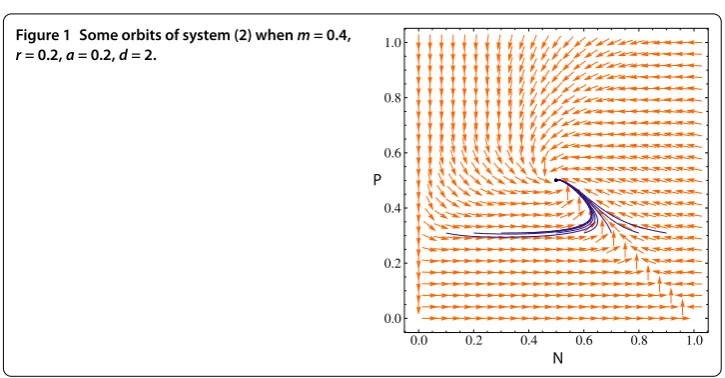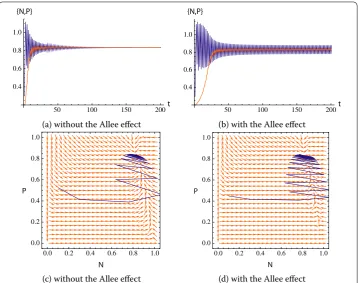R E S E A R C H
Open Access
Stability and invariant manifold for a
predator-prey model with Allee effect
Ünal Ufuktepe
1*, Sinan Kapçak
1and Olcay Akman
2*Correspondence: unal.ufuktepe@ieu.edu.tr 1Department of Mathematics, ˙Izmir
University of Economics, ˙Izmir, Turkey
Full list of author information is available at the end of the article
Abstract
Predator-prey models are similar to host-parasite and host-parasitoid models. We investigate the stability and invariant manifolds of a discrete predator-prey model by using center manifold theory which is not addressed in Çelik and Duman (Chaos Solitons Fractals 40:1956-1962, 2009), and Wanget al.(Ecol. Complex. 8:81-85, 2011).
1 Introduction
Predator-prey models are similar to host-parasite and host-parasitoid models. In this sys-tem, the predator does not live on the host. The prey serves as a food source for the preda-tor. There are many interactions between any pair of biological species; if two species compete for limited resources or one of the species preys upon the other, then one of the species is extinct.
The dynamic relationship between the interacting species has been one of the domi-nant themes in both ecology and mathematical ecology due to its universal importance. Recently many authors have explained the dynamics of competition and predator-prey models.
The following discrete time prey-predator system was studied by Çelik and Duman with an Allee effect on the prey population [], and by Wang, Zhang, and Liu with Allee effects both on prey and predator []:
Nt+=Nt+rNt( –Nt) –aNtPt,
Pt+=Pt+aPt(Nt–Pt),
()
where the parametersa,rare positive,Ntis prey density at timetandPtis predator density
at timet,ris the intrinsic growth rate. The termaNtisper capitapredator increase due to
prey consumption. Çelik and Duman [] claimed that the eigenvalues for the fixed point (, ), which is a non-hyperbolic fixed point, areλ= andλ= , but the corresponding Jacobian matrix for this point is
J=
The Allee effect was first described by ecologist Allee []. The Allee effect may be caused by a variety of mechanisms applicable in small populations. The presence of Allee effects indicates that there is a minimal population size necessary for a population to maintain itself in nature. Interest in the dynamics of small populations, including Allee effects, has increased in recent years. Interest in how small populations interact with other popula-tions, including predator-prey systems, has also increased. Allee effects can occur at the higher tropic level (e.g., predator, parasite), at the lower level (e.g., prey, host), or during interaction between these levels. Adding Allee effects to a predator-prey system can be destabilizing, depending on the formulation of the equations and where Allee effects are added [].
In this paper, we consider the system subject to equations () when the predator pop-ulation is subject to an Allee effect which is more general than described by the system of equations (.) in [], and we also use the center manifold theory for non-hyperbolic equilibrium points []. with an Allee effect on the predator discussed by Wang, Zhang, and Liu []. The aim of this paper is to investigate stability of model () and analyze the stability of the exclusion fixed point, which is non-hyperbolic, for the particular cases whend= andd= by using the center manifold theory which is not addressed in [, ].
2 Stability of system (2)
In this section we investigate the stability condition for system ().
The fixed points are (, ), (, ), and (ar+r,ar+r). The Jacobian matrix of the planar map
The Jacobian matrix for the extinction fixed point (, ) is
J=
(, ) is unstable since one of the eigenvaluesJ is greater than . The Jacobian for the exclusion fixed point (, ) is
J=
Figure 1 Some orbits of system (2) whenm= 0.4, r= 0.2,a= 0.2,d= 2.
We now discuss the coexistence of the fixed point,i.e., (a+rr,ar+r): the Jacobian matrix for this point is
J∗= ⎛ ⎝ a+r–r
a+r –
ar a+r a(a+rr)+d
m+(a+rr)d –
a(ar+r)+d
m+(ar+r)d
⎞ ⎠.
By using the Jury conditions [], after some manipulation, we obtain the following theo-rem.
Theorem The positive fixed point(a+rr,ar+r)is asymptotically stable if and only if
<r(K+m)r+a(K–Kr) < a(K+m) –aKr– (K+m)(– +r)r,
where K= ( r a+r)
d.
In Figure , we give the numerical evidence for some particular values of the parameters that the positive fixed point is asymptotically stable.
3 Instability of an exclusion fixed point
In this section, by using the center manifold theory, we show that for some values ofdfor system (), the fixed point (, ) is unstable.
Theorem For system(),the following statements hold true: (a) Ifd= ,then(, )is unstable.
(b) Ifd= ,then(, )is unstable.
Proof The eigenvalues of the Jacobian matrix corresponding to the system given in () at the point (, ) areλ= –randλ= . Ifr> , then|λ|> and (, ) is unstable.
Now, let us consider the case where <r< in which the eigenvaluesλ,λare subject to|λ|< andλ= .
system is
According to system (), it becomes
ut+= ( –r)ut–avt+f˜(ut,vt),
Consider the center manifoldv=h(u). Let us assume that the maphtakes the form
h(u) = –r
au+αu
+βu+Ou, α,β∈R.
This leads to the evaluation of two constantsα andβ. The functionhmust satisfy the center manifold equation
h( –r)u–ah(u) +f˜u,h(u)–h(u) –g˜u,h(u)= .
By using the Taylor series expansion, we solve the functional equation above yielding
Thus, on the center manifoldv=h(u), we have the following map:
S(u) = –u(( +m)r
u( +u) +ma(–m+ru( +u)))
ma .
SinceS() = andS() = –mr< , the exclusion fixed point (, ) is unstable. (b) Similarly, whend= , the new system is given by
ut+= (ut+ ) –r(ut+ )ut–a(ut+ )vt– ,
The Jacobian of the planar map which is given in () at the point (, ) is
˜
The equations in system () become
ut+= ( –r)ut–avt+f˜(ut,vt),
Consider again the center manifoldv=h(u). Let us assume that the functionhtakes the form
h(u) = –r
au+αu
+βu+Ou, α,β∈R.
Now we can evaluate the constantsαandβ. The functionhmust satisfy the center man-ifold equation
h( –r)u–ah(u) +f˜u,h(u)–h(u) –g˜u,h(u)= .
Utilizing the Taylor expansion, we solve the above functional equation
αr= and
–aα+ (α+β)r+ r
(a) without the Allee effect (b) with the Allee effect
(c) without the Allee effect (d) with the Allee effect
Figure 2 Trajectories of the prey-predator system: the Allee effect stabilizes the system.r= 2.5,a= 1.9, d= 2;(a),(c)m= 0;(b),(d)m= 0.1.
Solution of the above set of equations isα= ,β= –mar. Hence
h(u) = –r
au– r
mau .
Thus, on the center manifoldv=h(u), we have the following map:
R(u) =mau+r
u( +u)
ma .
Since R() = andR() = , we need to calculate the Schwarzian derivative [] at the origin. Since the Schwarzian derivative at the origin is mar > , we conclude that the fixed
point (, ) is unstable.
(a) without the Allee effect (b) with the Allee effect
(c) without the Allee effect (d) with the Allee effect
Figure 3 Trajectories of the prey-predator system: the Allee effect destabilizes the system.r= 2.5, a= 0.5,d= 2;(a),(c)m= 0;(b),(d)m= 0.3.
Table 1 The Allee effect may stabilize or destabilize the system
Figure r a d m Fixed point Initial point
2(a), 2(c) 2.5 1.9 2 0 Unstable (0.3, 0.2) 2(b), 2(d) 2.5 1.9 2 0.1 Stable (0.3, 0.2) 3(a), 3(c) 2.5 0.5 2 0 Stable (0.3, 0.2) 3(b), 3(d) 2.5 0.5 2 0.3 Unstable (0.3, 0.2)
Competing interests
The authors declare that they have no competing interests.
Authors’ contributions
All authors contributed equally and significantly in writing this paper. All authors read and approved the final manuscript.
Author details
1Department of Mathematics, ˙Izmir University of Economics, ˙Izmir, Turkey.2Department of Mathematics, Illinois State
University, Normal, USA.
Received: 11 April 2013 Accepted: 7 November 2013 Published:03 Dec 2013
References
1. Çelik, C, Duman, O: Allee effect in a discrete-time predator-prey system. Chaos Solitons Fractals40, 1956-1962 (2009) 2. Wang, W-X, Zhang, Y, Liu, C: Analysis of a discrete-time predator-prey system with Allee effect. Ecol. Complex.8, 81-85
(2011)
3. Elaydi, S: Discrete Chaos: With Applications in Science and Engineering, 2nd edn. Chapman & Hall/CRC, London (2008)
4. Allee, WC: The Social Life of Animals. Book Club, London (1941)
10.1186/1687-1847-2013-348
Cite this article as:Ufuktepe et al.:Stability and invariant manifold for a predator-prey model with Allee effect.


